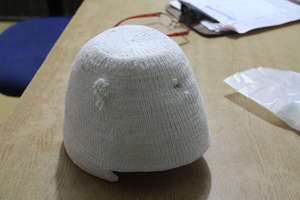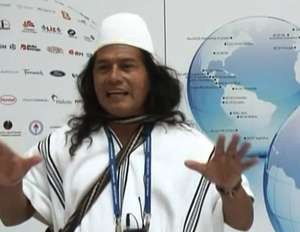SURVIVAL INTERNATIONAL, 12 November 12 - - One of Colombia’s most important Indian leaders has narrowly escaped an attempt on his life. Rogelio Mejía, the leader of the Arhuaco tribe of northern Colombia, was traveling in a car which was stopped at a roadblock by a group of armed men and riddled with bullets.
Mr Mejía was hit in the head when a bullet passed through his hat, but miraculously was only lightly wounded. He escaped the gunmen after fleeing
from the car.
A Survival International researcher who was traveling with Mr Mejía escaped injury, but was interrogated at gunpoint by the assailants for ten minutes as to Mr Mejía’s whereabouts. The gunmen fled when they heard a police car approaching.
 Mr Mejía's car was hit by 40 bullets, but he miraculously escaped serious injury.
Mr Mejía's car was hit by 40 bullets, but he miraculously escaped serious injury.
© Survival
The incident happened just outside the frontier town of Pueblo Bello, in the foothills of the Sierra Nevada de Santa Marta. Pueblo Bello has been a source of violence within the Arhuaco territory for decades. In June a 13-year old Arhuaco girl was raped, tortured and killed there; like virtually all crimes committed against Indians in Colombia, no-one has been punished.
The Arhuaco have been at the forefront of the Indian movement in South America. Many of their leaders have been assassinated, and countless others killed in the quasi-civil war that has raged in their territory between drug gangs, left-wing guerrillas and the army.
Several of their leaders, including Leonor Zalabata of the Arhuaco organization Confederación Indígena Tayrona (CIT), have received death threats.
 A bullet passed through Mr Mejía's tutusoma, the traditional Arhuaco hat, but only grazed his skull.
A bullet passed through Mr Mejía's tutusoma, the traditional Arhuaco hat, but only grazed his skull.
© Survival
In 1990 their three most important leaders, Luis Napoleón Torres, Hugues Chaparro and Angel María Torres, were tortured and killed – no-one has ever been punished for the crime.
Stephen Corry, Survival International’s Director, said today, ‘The Indians of the Sierra Nevada have maintained an ‘island’ of laws and peace in a region which has been submerged in violence for generations. If the Colombian government has any authority at all, it must protect them and bring the would-be assassins to justice. Nowhere is it more clearly shown that the notion that tribal peoples are more violent than industrialized ones is complete garbage.’
Notes to Editors:
The Survival researcher, whose identity is confidential, is available for interview. Contact Survival’s press office for more information, details below.
Mr Mejía’s official title is the ‘Cabildo Gobernador’ (‘Council Governor’) of the Arhuaco – their principal political leader. Other figures of authority amongst the Arhuaco are the ‘mamos’, or religious leaders.
The Arhuaco are one of four related tribes who live on the Sierra Nevada de Santa Marta in northern Colombia. The others are the Kogi, the Wiwa and the Kankuamo. The Indians refer to themselves as the ‘Elder Brothers’; everyone else is known as the ‘Younger Brothers’.
In 1982 the Arhuacos expelled the Capuchin missionaries who had been present on their land for many years.
Read this online: http://www.survivalinternational.org/news/8813
Survival International helps tribal peoples defend their lives, protect their lands and determine their own futures. Founded 1969.


Comments
murderous paramilitaries are a predictable result
Asking government for protection against paramilitaries is like asking an earthquake for protection against tsunami - only difference being that the earthquake will not argue it had not been asked for protection when complaint is made later. The relationship between these destructive forces is one-sided, the former can only generate the latter but it cannot stop it. From the inside, one politician described it as a train without brakes, even in a country where corporate influence is considerably less than in this one. When the wishful thinking of unscrupulous businesses unearths the venality of the most totalitarian elements of the state bureaucracy, murderous paramilitaries are a predictable result, just as much as pollution, destruction and contamination are to be expected from coal mining.